
The Windmill Palm Tree, scientifically known as Trachycarpus fortunei, is renowned for its captivating appearance and effortless maintenance. This exceptionally cold-tolerant palm species thrives in USDA zones 7b to 11, making it an excellent choice for landscaping.
Originating from China, this palm tree thrives in regions with cooler summers and can be successfully cultivated in states such as Alaska, Alabama, Delaware, Maryland, Massachusetts, Mississippi, New Jersey, New York, Oklahoma, Tennessee, and more.
Buy Chinese Windmill Palm on Amazon »
Quick Facts:
| Scientific name: | Trachycarpus fortunei |
| Common names: | Windmill Palm, Chusan Palm, Chinese Windmill Palm. |
| Origin: | Native to central and eastern China. |
| Growth Rate: | Slow. Up to 25 ft in height and 5 ft wide. |
| Cold Tolerance: | USDA Zones 7b (5 – 10 F) to 11 (above 40 F). |
| Light Req: | Partial shade to full sun. |
| Water Req: | Drought tolerant. |
| Soil Req: | Widely adaptable. |
| Fruit: | Yes. Blue. Not edible. |
| Propagation: | By seeds, germinating in 2 months |
Windmill Palm Appearance
Trachycarpus fortunei is a slow-growing palm, typically reaching heights of up to 25 feet and spanning a width of 5 feet. In the wild, it can even grow as tall as 40 feet.
Its trunk is slender and measures approximately 8 to 10 inches in diameter. The trunk is enveloped in a loose mat of coarse gray or brown fibers and tapers slightly at the base.
The windmill palm boasts palmate leaves resembling swords that can span up to 4 feet in diameter. These leaves vary in color from dark green to yellow-green, with a silvery hue on the underside.
Notably, the leaves grow more upwards than outwards, and the petiole, or leaf stem, extends to about 1 ½ feet and is adorned with sharp thorns.
Windmill Palm Flowers and Fruits
This palm tree exhibits dioecious characteristics, meaning that male and female flowers grow on separate plants. During early summer, male plants produce large plumes of yellow flowers, while female plants display greenish blooms.
The flowers are borne on 3-foot-long branched stalks. Eventually, the female plants’ flowers transform into bluish-black fruits, which are approximately 1/2 inch (1.3 cm) in diameter and ripen in mid-fall. It’s worth noting that the Windmill Palm’s fruit is not suitable for consumption.
How To Care For Windmill Palm
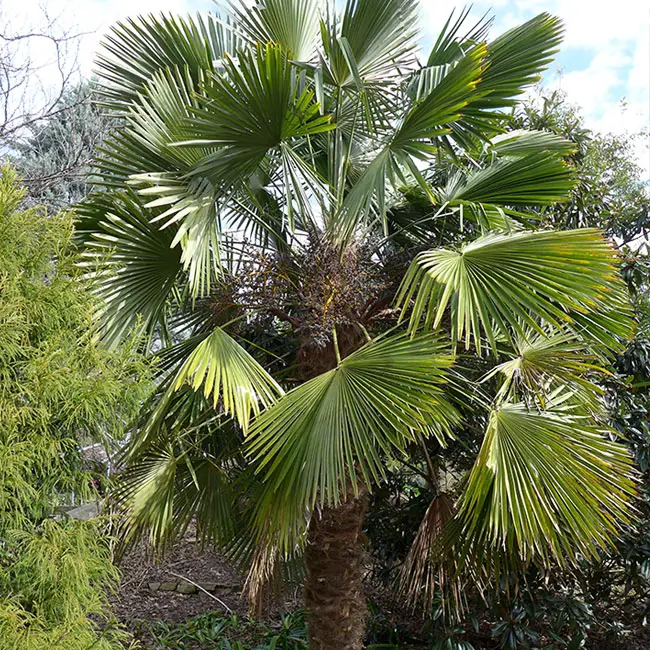
This plant exhibits remarkable adaptability to a wide range of soils, provided they offer good drainage. Although it can endure short periods of drought, its optimal performance is achieved through regular watering and feeding. Additionally, it boasts a commendable tolerance to salt.
While it generally thrives with minimal issues, it is worth noting that the Windmill Palm can be mildly susceptible to conditions such as lethal yellowing and phytophthora bud rot. However, these concerns are relatively rare and tend to arise only when the plant is weakened or injured.
To maintain its aesthetic appeal, it is advisable to plant the Windmill Palm in an area with some wind protection, as this helps prevent leaf tearing and promotes healthy growth.
Light
Trachycarpus fortunei exhibits versatility when it comes to its sunlight preferences. It can thrive in partial shade or full sun, although growth may be significantly slower when subjected to full shade. The ideal amount of sunlight depends on the local climate.
In regions with scorching summers and frequent droughts, it is advisable to provide partial shade to prevent leaf burn.
On the flip side, if you reside in a climate characterized by cool summers and cold winters, full sun exposure is a more suitable choice. For those cultivating this plant indoors, seek out a well-lit spot with ample sunlight.
Soil
This plant flourishes in various soil types, including heavy clay, eliminating the need for soil amendments when planting a newly acquired specimen.
It adapts well to both alkaline and acidic soil, provided there is adequate drainage. Therefore, it’s essential to assess the soil’s drainage capabilities before planting.
Watering
Trachycarpus fortunei is particularly vulnerable to drought stress until it becomes fully established, a process that typically takes about three years.
During the initial three months after planting, water the newly introduced palm every other day, and subsequently, water it weekly for the remainder of its first year. It is crucial to prevent the soil from drying out, especially on scorching summer days.
If you are cultivating this plant in a container, ensure that the soil remains consistently moist but well-drained, as prolonged exposure to soggy soil can lead to root rot.
Fertilizing
While this plant is not overly demanding regarding soil quality, it thrives when provided with ample soil fertility. Regular fertilization is recommended to prevent nutrient deficiencies.
Apply a high-quality palm fertilizer with a continuous-release formula twice a year during the growing season. Additionally, occasional application of Epsom salt (magnesium sulfate) in spring seems to benefit this palm.
If it’s growing in clay soil deficient in iron, consider incorporating minerals containing high chelated iron to maintain vibrant foliage and promote canopy development.
Temperature
It is well-suited for cultivation in USDA Zones 7b (with temperatures as low as 5°F) through 11 (with temperatures above 40°F). Trachycarpus fortunei is an exceptionally cold-hardy palm, capable of thriving in all of Zone 8 and most of Zone 7b with minimal or no winter protection.
In some instances, it can even endure the colder conditions of Zone 7a and select microclimates within Zone 6 with a degree of winter protection, although you should anticipate the loss of foliage during the coldest winter months.
It’s important to note that there’s a significant contrast in cold tolerance between young and mature Windmill palms. As the plant matures, it develops a larger root system, making it substantially hardier.
Reports indicate that mature Windmill palms in Ohio have survived temperatures as low as -14°F. While individual plants may vary, on average, a mature Windmill palm can withstand temperatures as low as approximately -10°F without any protective measures.
However, it’s important to understand that this survival often results in significant leaf damage, typically occurring at around 10°F.
This palm appears to be quite sensitive to wind chill damage, and therefore, it should be provided with as much shelter as possible. Naturally, as it grows larger, offering adequate wind protection becomes more challenging. Fortunately, it tends to recover quickly in the following growing season.
For those residing in colder regions, the trade-off of enjoying a visually appealing palm for approximately eight months of the year may be well worth it.
Pruning
This plant does not require extensive pruning. Simply trim off dry, brown fronds as close to the trunk as possible.
Insects and Diseases
Windmill palm trees are generally resilient against insect infestations and disease. However, they may occasionally encounter pests such as scales and palm aphids.
Additionally, there is a risk of infection from root rot, moderate susceptibility to lethal yellowing disease, and the development of leaf spots.
Propagating
Propagated through seeds, Trachycarpus fortunei offers a relatively straightforward germination process, typically taking 8 to 12 weeks. To start, soak the seeds in water for a few days.
Then, plant them at a depth equal to their width in a mixture of rich potting soil and peat moss. Ensure they receive ample sunlight and maintain regular watering.
The germination of these seeds may take anywhere from one to seven months. You can consider replanting once the seedling’s first leaf exceeds 2 inches in length.
Landscaping With Windmill Palm
This palm serves as an excellent focal point in a small garden or courtyard. In larger landscapes, the presence of several windmills enhances the visual appeal. If planting near a house or other structure, provide approximately 5 feet of space for the fronds to spread.
For rows of Windmill palms, leave approximately 7 feet of space between plants. This striking palm is ideal for lining driveways or accenting entryways. It can thrive both individually and in groups of varying heights, especially when placed in front of a fence or wall.
Windmill palms coexist harmoniously with a wide variety of companion plants and can serve as a sturdy anchor for a planting bed featuring flowering shrubs or vibrant tropical specimens.
Growing Windmill Palm Indoors
These palms also make fantastic indoor houseplants due to their slow growth rate, adaptability to different soil types, and tolerance for low humidity levels. To cultivate them indoors successfully, ensure they receive ample sunlight, consistent watering, and regular fertilization.
If you decide to move them outdoors during the warmer months, do so gradually to prevent sunburn, as indoor palms can become stressed when suddenly exposed to direct sunlight.
Maintain consistently moist soil during the hot summer months, but allow the soil to dry between waterings in the fall and winter. Using distilled or filtered water can help prevent chemical buildup.
Unlike many other houseplants, this slow-growing palm doesn’t require annual repotting. However, it’s advisable to repot every three years to refresh the soil, even if you retain the same pot.
Fertilize the plant twice a year, in spring and summer, with a slow-release fertilizer suitable for indoor palms. Be vigilant for signs of magnesium deficiency, which can manifest as yellow spots on the leaflets.
Other Butia Varieties
The genus Trachycarpus encompasses several closely related species known for their remarkable cold tolerance. One such example is Trachycarpus wagnerianus, often referred to as the Miniature Chusan Palm.
This variety is essentially a dwarf version of the Windmill Palm but is distinguished by its stiffer and shorter leaves, which are less susceptible to wind damage.
Trachycarpus takil, also known as the Kumaon palm or Himalayan Windmill Palm, is found at extremely high elevations in the Himalayas. Notably, it exhibits significantly greater cold hardiness than the Chinese Windmill Palm, readily enduring temperatures dropping below 0°F.
It can also achieve greater height than Trachycarpus fortunei, boasting a larger crown and a thicker, often bare trunk.
In contrast, Trachycarpus martianus (Nepal Windmill Palm) and Trachycarpus latisectus (Sikkim Windmill Palm or Windemere Palm) are less cold-hardy than the Windmill Palm. They feature bare, ringed trunks rather than the furry appearance of their counterpart.
Frequently Asked Questions
In this section I want to answer some of the most popular questions I get about this plant.
How Fast Do Windmill Palms Grow?
The Windmill Palm is known for its slow growth, averaging around 10-15 inches in height per year, ultimately reaching a maximum height of 25 feet.
Adequate moisture in the soil can accelerate its growth and enhance its appearance. It’s advisable to increase watering during the warm months and reduce it during the cooler winter months.
While the Windmill Palm is highly drought-tolerant, irregular watering and prolonged drought can significantly impede its growth rate.
Are Windmill Palm Fruits Poisonous To Dogs and Cats?
According to ASPCA, Windmill Palm fruits are NOT toxic to cats and dogs. You pet might have an upset stomach but these fruits are not poisonous.
How to Protect Windmill Palm From Cold?
Despite their impressive cold tolerance, Windmill Palms grown in Zone 7 will require winter protection. At the very least, you can provide heavy mulching and apply a fungicide/bactericide spray.
For more comprehensive protection, consider constructing a wire or burlap enclosure roughly 1 foot away from the trunk. This enclosure should be tall enough to safeguard the entire trunk and the lower portion of the crown, often referred to as the ‘crown cavity.’
Spray the entire plant with an anti-transpirant to reduce moisture loss and apply a fungicide/bactericide spray to prevent crown rot. Next, fill the entire enclosure with a mixture of pine straw and dry leaves or simply use dry leaves.
This meticulous treatment regimen can enable your Windmill Palms to survive even when temperatures plummet below 0°F!
Windmill Palm Pictures
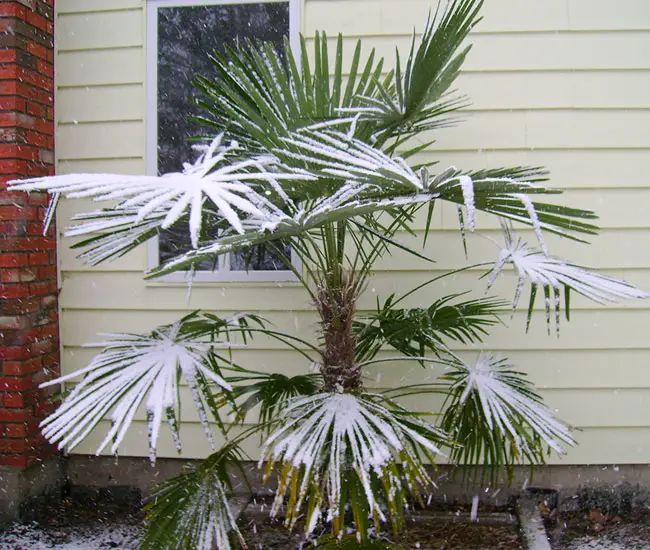

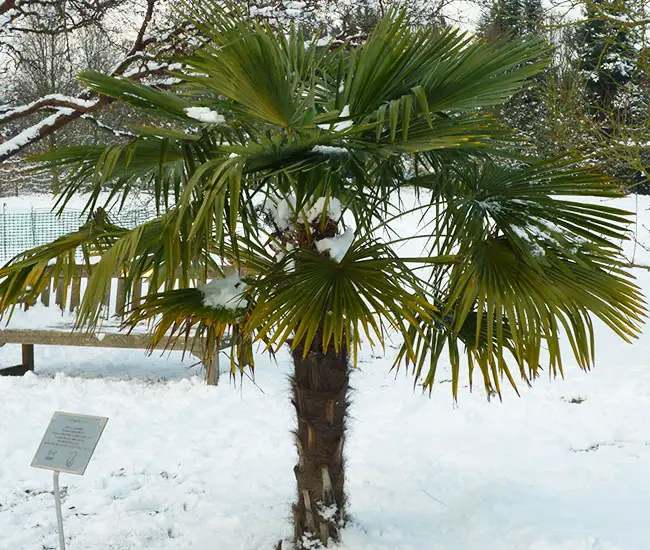
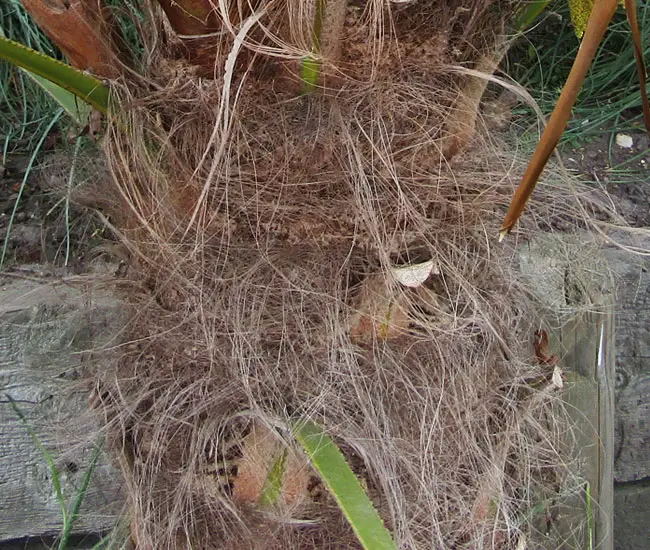
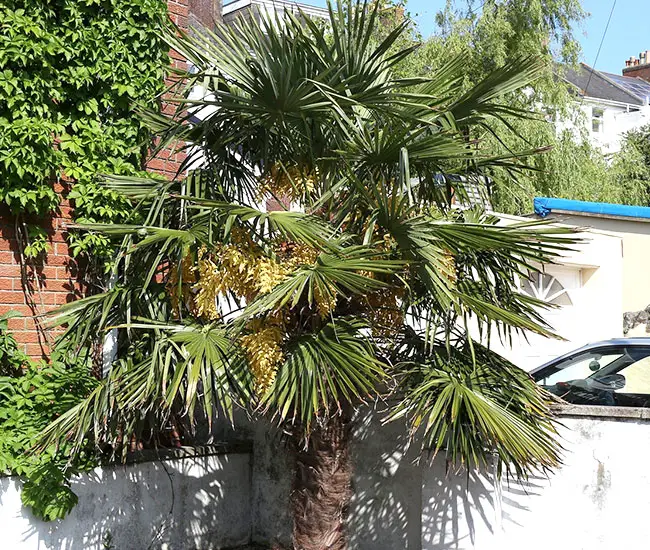
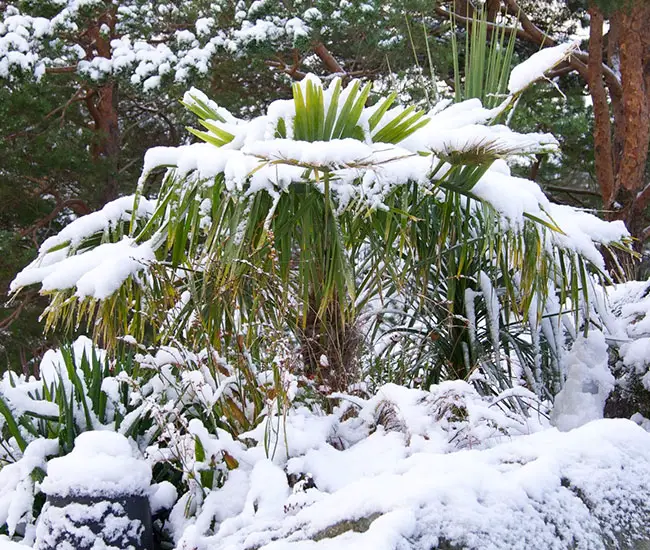
More information can be found on EDIS and Floridata sites.
Buy Chinese Windmill Palm on Amazon »
